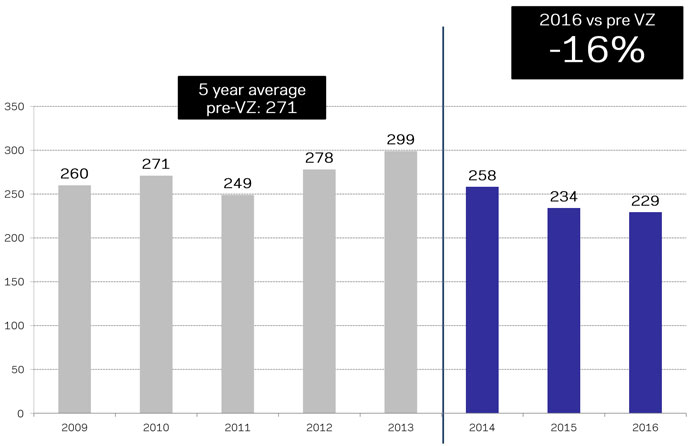NYC Traffic Deaths Are Falling, But Not Fast Enough

For the second consecutive year, traffic fatalities reached a new low in New York City, according to crash data released by City Hall this morning [PDF]. Progress slowed substantially in 2016, however, and all the improvement was limited to motor vehicle occupants and motorcycle riders.
The results indicate that the de Blasio administrations’s traffic safety efforts are working, but that the mayor and his agencies aren’t acting decisively enough to reach the Vision Zero goal of eliminating traffic deaths by 2024.
Total traffic deaths declined from 234 in 2015 to 229 last year, while pedestrian deaths increased from 139 to 144 and cyclist deaths increased from 14 to 18.
“The first three years of Vision Zero in New York have been the safest three-year period in history on our City’s roadways,” said Transportation Commissioner Polly Trottenberg in a statement that noted NYC’s continued improvement bucks the national trend. Nationwide, traffic fatalities rose 7.1 percent in 2015, and early numbers indicate an increase in 2016 as well.
At a press conference this morning, city officials laid out the steps DOT and NYPD took to improve traffic safety in 2016. Enforcement of speeding and failure to yield — violations that factor into a large share of traffic deaths — has increased, and DOT has escalated the installation of safer signals and street designs.
DOT Deputy Commissioner Ryan Russo highlighted the 1,200 leading pedestrian intervals — signals that give pedestrians a head start on turning drivers — installed since 2014. The number of pedestrians killed by MTA bus drivers declined from 10 in 2015 to three last year, which Russo credited to 157 LPIs installed by bus stops. In 2016, the city put down 400 speed humps and implemented 105 street redesign projects, which can range in scope from a single intersection to miles of roadway.
The most substantial safety improvements have come at locations DOT identified as high priorities in its 2015 pedestrian safety action plans. Last year, 72 percent of DOT’s redesign projects were in priority locations, Russo said. Compared to the five-year average before Vision Zero was initiated in 2014, traffic fatalities at all the high-priority locations in the city were down 29 percent last year.
Still, in 2016 the city did not match the rate of improvement in the previous two years:

One factor may be that in 2014 and 2015, the city substantially expanded its automated speed enforcement program. A speed camera typically “reduces speeding violations by 50 percent within its first year,” according to the city [PDF]. But Albany leaders failed to pass a bill enabling a larger speed camera program in 2016.
Without more automated speed enforcement, DOT’s street redesign efforts are even more essential to achieving the city’s Vision Zero goals. But for two years, de Blasio has declined calls from City Council members to increase funding for street redesigns.
Asked whether additional funding would speed up the pace of progress, Russo deflected the question, citing the extensive preparation and outreach that the city conducts for redesign projects. “This isn’t simply just like repaving streets, [where] for every dollar you get a certain amount of square foot of repaving,” he said.
“We have to keep in mind that the last three years were the safest three years for pedestrians that we’ve ever had,” Russo said. “What we’re confident is that if we hadn’t done what we did — with the enhanced enforcement, with the education, with all the street engineering that was focused on the priority corridors and priority locations — we certainly would be talking about a much higher number in that scenario.”





